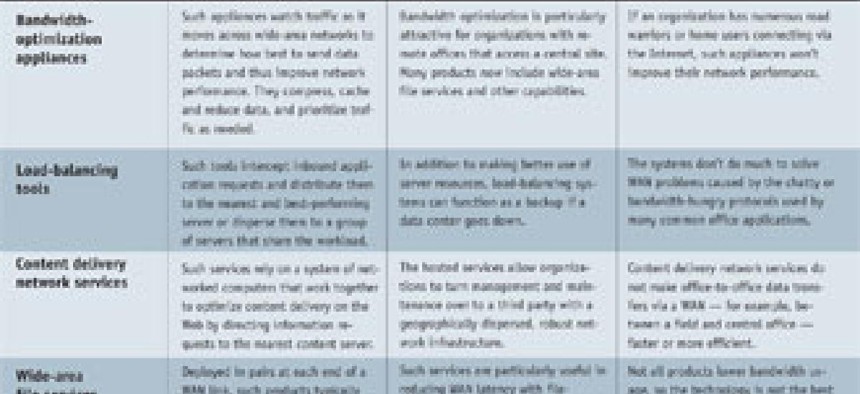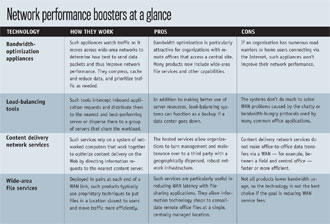Many paths to the fast lane

Agencies have multiple options to speed up their wide-area network links.
When the Department of Health and Human Services’ Office of Inspector General transitioned its older hub-and-spoke, frame-relay network more than two years ago to a faster mesh-style wide-area network, technical staffers expected that employees at the agency’s field and regional offices would applaud the upgrade.
“You’d think because of the increased bandwidth, you would have heard a lot of rave reviews from end users,” said Chris Finucane, chief technology officer and director of the OIG’s service and support division. But that didn’t happen.
In fact, some employees were complaining about the slow response times of certain applications, such as e-mail.
Meanwhile, the agency was exploring the idea of simplifying its information technology architecture by consolidating and reducing the number of servers from each of its 10 regional offices to four or five central servers that employees would access via the meshed network. Finucane worried that the consolidation would have a negative effect on network performance and response times.
“In the back of my mind, a warning bell went off about how we were going to do this,” he said. “The people that worked in regional offices were used to [local-area network] connectivity. Since we were hearing negative reviews about connectivity and response times, I thought we might hear the same from the regional offices, and I didn’t want to hear those same complaints.”
Finucane and his team analyzed the problem. They were certain that throwing more bandwidth at the situation — a common but expensive and often unsuccessful way to address unsatisfactory network speeds — wasn’t the answer.
Sometimes adding bandwidth does not improve performance because it does not address the bandwidth-hungry protocols that can clog network pipes no matter how big they get.
After more research, the OIG turned to a bandwidth optimization solution, in this case a network appliance product from Riverbed Technology that is designed to improve WAN performance by tuning and thus accelerating the traffic that traverses the network. The agency said it installed 95 Riverbed appliances throughout its offices in four months and had an improved WAN and happier employees by January 2006.
Bandwidth optimization appliances are just one type of a growing collection of products designed to improve performance by more intelligently moving data across the WAN and among the associated servers that sit on that network. Other options include load-balancing software, content delivery network services and wide-area file services (WAFS) solutions.
The products address different aspects of network performance, often delivering specific benefits related to the focus area. So it is important to choose the right solution for the problem you are trying to solve.
Different strokes
Bandwidth-optimization appliances are designed to boost WAN performance and are typically deployed at the two endpoints of a wide-area link, such as between a remote and a central office.
The appliances use a variety of techniques to speed the flow of data, such as caching, traffic prioritization and protocol optimization, which reduces the inherent bandwidth-hungry nature of the most common TCP/IP-based applications.
The goal of the products is to reduce network latency, which affects speeds and bandwidth utilization. The latter determines available capacity.
There are a number of vendors in this space, including Riverbed, Ipanema Technologies, Blue Coat Systems, Expand Networks, Juniper Networks, Certeon and Converged Access. Juniper offers optimization appliances it acquired when it bought Peribit Networks a year ago.
Load-balancing systems are designed to route traffic to the server or data center that is best able to handle it at the time, so no server becomes a chokepoint. Vendors include Radware and F5 Networks.
Load-balancing systems can improve network performance, and they add layers of security by providing failover capabilities in the event that a data center goes down.
That is why the city government of Tampa, Fla., said it chose Radware’s AppDirector. The city’s public Web site is a critical component for delivering services: In June, it processed about $850,000 in transactions that included utility bills, parking permit and ticket payments, and business taxes.
“A lot of people are using it for a lot of different purposes,” said Rob Edwards, senior applications programmer analyst for Tampa.
AppDirector provides failover capabilities in case the city’s primary Web server goes down because it can automatically and intelligently route traffic to a second, mirrored site at another location.
“It gives me peace of mind as much as anything,” Edwards said. “I don’t have to worry in the middle of the night about whether the service will go down. I’ve always got secondary service available.”
Content delivery network services cache frequently accessed data on servers closest to the users who access that data, thereby distributing the workload and improving average response times. Akamai Technologies and Netli are two companies in this market.
Organizations rely on content delivery network services when a large number of users access data and applications housed on a public Web site.
Finally, WAFS tools are designed to improve access to files — typically those that use the Common Internet File System (CIFS) protocol in Microsoft Windows-based networks — via caching and protocol-optimization techniques. The products in this category are also often called application accelerators.
WAFS vendors include Packeteer — which recently bought another WAFS vendor, Tacit Software — and Cisco Systems.
WAFS can help improve latency troubles caused by what Eric Siegel, a senior analyst at the Burton Group, calls ping-pong protocols, such as CIFS.
“Instead of going from the client to the server and getting the file that’s been requested in one shot, there’s all this back and forth, dozens or hundreds of times, just to bring the file over,” Siegel said. “And every time there’s a back-and-forth, there’s another tenth or a twentieth of a second blown away.”
WAFS products traditionally did not work at the network level and therefore did not address bandwidth consumption issues. However, many WAFS vendors have added compression techniques to their products to improve bandwidth performance.
Navigating the market
Trying to pick the right solution from the various options is getting more difficult as vendors add functions that go beyond their traditional product categories.
For example, bandwidth-optimization appliances can also apply WAFS techniques. A case in point: Expand recently bought DiskSites, a WAFS vendor.
And load-balancing products or application accelerators can have built-in compression mechanisms that coordinate with browser software on a PC to squeeze data into smaller files that traverse a network more quickly.
Analysts recommend that organizations take a step back before buying anything.
“Maybe the most fundamental question they need to ask is, ‘Where are my users located and what are they doing?’” said Donald Czubek, president of analyst firm Gen2 Ventures.
“If a company needs to improve the performance of a Web-based application, then the solution that will work for them is an application accelerator,” he added.
Organizations also need to decide which applications are most critical. Officials at Charlotte County Public Schools in southwest Florida wanted to ensure that their 17,500 students could access an online learning software package that is aligned with state educational standards in math, science, language arts and social studies.
In addition, the school system is distributing high-quality, on-demand video for its high schools and providing administrative applications to its teachers.
Adding expensive bandwidth was not an option. So Chris Bress, the school system’s chief information officer, chose Blue Coat Systems’ Blue Coat SG bandwidth-optimization appliances.
“Budgets are not extremely large, and one of the things I like best is that it performed multiple jobs inside one box,” Bress said.
The appliances cache files and filter information — an important capability for an organization that must monitor and block certain content.
The appliances also manage bandwidth by curbing the amount allotted to traffic coming from certain Web sites, such as downloads from sites containing drumming competition videos, while opening more bandwidth for the online educational software.
The school system has been using the bandwidth-optimization appliances for more than a year. “The kids and teachers like it because performance has increased,” Bress said. “I’m happy because they’re happy but also because I have an amazing amount of reports available to me about how the network is performing and being used.”
Bacheldor has nearly 20 years of journalism experience, much of that covering information technology.
NEXT STORY: SSA asks for bids for voice-over-IP network






